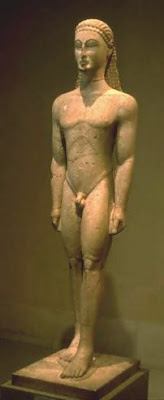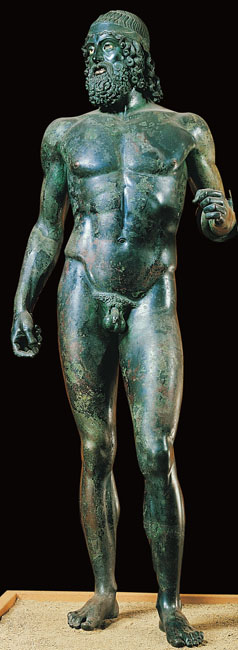Cards In This Set
| Front | Back |
 Name, Date, Medium, Era from? |
Geometric Krater – 740 BCE- Craft
Pottery, one of the several kinds of shapes. Popular style, large neck and body, used to mix things, like water and wine (watered down wine). Designs geometric, lines and zig-zags. Figures are simplified, geometric shapes. Man in chariot, long tunic (triangle shape), with two horses (also triangle shape), very distorted in shapes. Krater would be placed in cemetery to honor the spirit and remember them. Actions on the krater symbolized funereal- chariot races or foot races- held athletic contests as a way to deal with emotions. Process of grief was spent moving the body. Greeks believed in “sound mind and sound body.” Female figures on Krater, have hands on head, showing signs of grief. |
 Name, Date, Medium, Era from? |
5-3 Mantiklos Apollo- 700-680 BCE- Sculpture
Small in size. Name scratched into leg. Apollo (Sun god)- shows up in chariot. Hole in head, used to anchor in a shape of the sun on/over the head. Long neck and small waist (More geometric shapes). Not at all accurate to human proportions. |
 Name, Date, Medium, Era from? |
5-8 Kouros (Young Male Figure)- 600 BCE- Sculpture
Statue, many found, heroic (6'2”). Heros should be taller than normal people. Males always nude. Positive, athletic body, rigid, foot forward (almost Egyptian, major influence). Change in accuracy to be more “believable”. |
|
Name, Date, Medium, Era from? |
5-7 Lady of Auxerre – 650-625 BCE Sculpture
Name of town in which she was found. Female figure wearing drapery (Females were usually always clothed). Slightly Egyptian style, rigid, not accurate. |
 Name, Date, Medium, Era from? |
5-11 Peplos Kore- 580 BCE Sculpture
(Dress) She is wearing (Pepolis) rigid like males. Painted, left arm gone, once outstretched. Holding an offering basket. Stood outside temple. |
 Name, Date, Medium, Era from? |
5-33 Kritios Boy 480 BCE Sculpture Classical Period
Contropposto: standing weight shift (counter). Knees don't line up, not rigid. beginning of the Classical Period. Artists figured out how to have statues lean and balance. May have been used same way as Kouros (offering suggestion outside of a temple). |
 Name, Date, Medium, Era from? |
5-34 Warrior 460-450 BCE Sculpture, Classical Period
Bronze-more expensive and appreciated. Only few have survived. One out of a pair found off the coast of the Italy. Found by a scuba diver “thought it was a dead body.” Heroic in scale, standing in contropposto. Bronze sculptures were mostly reused: melted down and made into new things. |
|
Name, Date, Medium, Era from? |
5-42 Iktinos and Kallikrates 447-438 BCE Architecture, Classical Period
The Athena temple in the Parthanon in Acropolis |
 Name, Date, Medium, Era from? |
5-47 Three Goddesses 438-432 BCE, Classical Period
Athens, Greece. Female, custom to be draped. “Clingy”, technique called “Wet drapery” broke the rule to show off female body. Skill developed in classical period. Cutting marble thin cloth revealing as if wet. |
 Name, Date, Medium, Era from? |
5-78 Reconstructed West Front from the Alter of Zeus in Pergamon – 175BCE – Architecture, Hellenistic period.
The most famous of all Hellenistic sculptural ensembles. The altar proper was on an elevated platform, framed by an ionic stoalike colonnade with projecting wings on either side of a broad central staircase. The subject of the frieze on the Altar of Zeus is the battle of Zeus and the gods against the giants. It is the most extensive representation Greek artists ever attempted of the epic conflict for control of the world. |
 Name, Date, Medium, Era from? |
5-79 Athena battling Alkyoneos 175 BCE Sculptures, Hellenistic
On the Alter of Zeus. Athena grabs the hair of the giant Alkyoneos as Nike flies in to crown her, is a quotation of the athena from the Parthenon's east pediment. Battling wages all on the alter. “Baroque” death depiction was normal. |
 Name: |
5-82 Nike Alighting on a Warship 190 BCE Sculpture
“Wet draping” method, to see form of female body. Taking off, about the fly. |
 Name: |
5-89 Laocoons and his sons (Early first century CE) Sculptures
Being attacked by snakes. Very dramatic. Apart of a story (Trojan War). Greeks vs Trojans;dragged on until greeks built large wooden horse to trick trojans. History; usually fought during the day (Greeks broke that rule) and all polytheistic with greek gods fighting each other on opposite sides. Laocoon was suspicious of horse and warned trojans about it. Posideon wanted greeks to win and sent sea snakes to attack and kill him to shut him up. Died because he was telling the truth. “Gift giving disaster.” |
 Name: |
7-2 Temple of Portunus 75 BCE Architecture
Temple for 2 gods; Goddess Fortunus “Lady luck”. Strong belief in luck and fate. Pray to her before they gambled. Portunus; god of ports. Prayed to him to watch over them when going to sea. “Good luck and safety.” |



